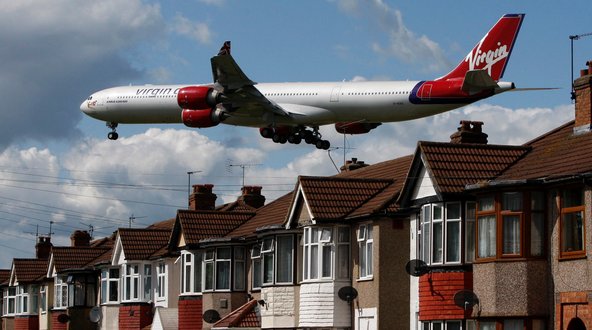The announcement gives the American plane maker orders for the new version worth more than $29 billion at list prices, a welcome bit of news for the Dreamliner program after troubles with its lightweight but volatile lithium-ion batteries grounded the entire 787 fleet for three months this year.
“Our team and our customers are excited about growing the product line and expanding our presence with this family of airplanes,” said Raymond L. Conner, the chief executive of Boeing’s commercial aircraft division. “Our ongoing investment in the 787 family is well founded.”
Boeing made its announcement on the second day of the Paris Air Show, soon after an announcement by its European rival, Airbus, that it had secured an $11.5 billion commitment from the British budget airline easyJet to purchase at least 135 of its smaller A320 single-aisle planes.
Boeing’s latest Dreamliner, known as the 787-10, is designed to seat up to 330 passengers, compared with the 210 to 290 seats on the models currently in production, and is meant to compete directly with the largest version of Airbus’s forthcoming A350-XWB, which made its inaugural flight last week.
Boeing said it had received firm commitments from three airlines and two lessors from North America, Asia and Europe. Air Lease Corporation, the American leasing company founded by Steven F. Udvar-Hazy, signed a memorandum of understanding on Tuesday for 30 of the planes. United Airlines, which already has six 787s in its fleet and has ordered at least 25 more, converted 10 of its existing orders into 787-10s and placed 10 new orders for the stretch version.
GE Capital Aviation Services, another lessor, firmed up a previously announced commitment for 10 planes and Singapore Airlines for 30. British Airways said it would buy 12 planes, subject to the approval of its shareholders.
Such a large initial order book for the 787-10 suggested that a bigger Dreamliner was probably overdue, analysts said.
“This is highly unusual example of the market launching a plane rather than the company,” said Richard Aboulafia, an aerospace analyst at the Teal Group in Fairfax, Va. “This plane is off to a very solid start.”
Boeing said it planned to begin deliveries of the 787-10 in 2018, just after Airbus says it expects to deliver the first 350-seat version of its A350, in 2017.
The competition between Boeing and Airbus in the market for wide-body jets in the 300- to 400-seat category has intensified as the nascent global economic recovery encourages airlines to invest in larger, longer-range aircraft after several years of brisk purchases of single-aisle jets like the Airbus A320 and Boeing 737.
With oil prices remaining stubbornly high, airlines are hoping to both replace older fuel-guzzling planes with newer models and maximize the number of passengers who can be carried on their lucrative long-distance routes. “’That means getting the most you can get in terms of aircraft length and number of seats,” Mr. Aboulafia said.
With a range of 7,000 nautical miles, or 13,000 kilometers, the larger 787 will not be able to fly as far as the A350 on a single tank of fuel; Airbus says the A350 will have a range of up to 8,400 nautical miles. But Boeing argues that its plane will cost less to operate.
“The 787-10 is 25 percent more efficient than airplanes of its size today and more than 10 percent better than anything being offered by the competition for the future,” Mr. Conner said.
Mr. Udvar-Hazy of Air Lease Corp. — which also has 25 Airbus A350s on order — said the shorter reach of the 787-10 was initially a concern in the negotiations with Boeing. But he noted that the range of the Boeing jet was still sufficient to cover “around 97 percent of all the significant city pairs in the world.”
In addition to the larger 787, Boeing is currently promoting a revamped version of its popular 777 jet, which would seat 350 to 400 passengers and be equipped with more fuel-efficient General Electric engines and an improved version of the same carbon-fiber wing as the 787. Scott Fancher, Boeing’s vice president for airplane development, said the company expected to make a formal decision to build the new 777 version by the end of this year.
A number of airlines, including the Doha-based Qatar Airways, have recently expressed interest in the larger 777, known as the 777x.
Akbar Al Baker, Qatar Airways’ chief executive, confirmed Tuesday that the airline was in discussions with Boeing to be the first customer for the 777x as an eventual replacement for its aging fleet of long-range 777s beginning in 2020. But with 80 of Airbus’s A350s on order, Mr. Al Baker said he would not be ordering any stretched Dreamliners.
“We already have the plane that fits our needs in this category,” he said.
Two years ago, concerned that it might lose customers to Boeing, Airbus redesigned its largest, 350-seat version of the A350, known as the A350-1000, to accommodate a more powerful engine that would extend the plane’s range and payload.
The change delayed the A350-1000’s planned entry into service by 18 months, and Airbus continues to struggle to attract customers to the larger variant. Just 110 of the 613 A350s on its current order book are for the A350-1000.
Boeing also reached a deal Tuesday to sell five more passenger versions of its revamped 747 jumbo jet to Korean Air, as well as six long-range 777s in a deal valued at around $3.6 billion at list prices. The new version of the 747, known as the 747-8, entered service in 2011, but it has faced tepid interest from airlines with only around 100 orders so far. Korean Air already has orders for five passenger versions and seven freighter versions of the 747-8.

Article source: http://www.nytimes.com/2013/06/19/business/global/boeing-confirms-plan-for-longer-dreamliner.html?partner=rss&emc=rss

